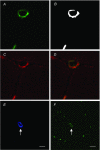The effect of different training modes on skeletal muscle microvascular density and endothelial enzymes controlling NO availability
- PMID: 25809076
- PMCID: PMC4933120
- DOI: 10.1113/JP270329
The effect of different training modes on skeletal muscle microvascular density and endothelial enzymes controlling NO availability
Abstract
It is becoming increasingly apparent that a high vasodilator response of the skeletal muscle microvasculature to insulin and exercise is of critical importance for adequate muscle perfusion and long-term microvascular and muscle metabolic health. Previous research has shown that a sedentary lifestyle, obesity and ageing lead to impairments in the vasodilator response, while a physically active lifestyle keeps both microvascular density and vasodilator response high. To investigate the molecular mechanisms behind these impairments and the benefits of exercise training interventions, our laboratory has recently developed quantitative immunofluorescence microscopy methods to measure protein content of eNOS and NAD(P)Hoxidase specifically in the endothelial layer of capillaries and arterioles of human skeletal muscle. As eNOS produces nitric oxide (NO) and NAD(P)Hoxidase produces superoxide anions (O2 (-) , quenching NO) we propose that the eNOS/NAD(P)Hoxidase protein ratio is a marker of vasodilator capacity. The novel methods show that endurance training (ET) and high intensity interval training (HIT), generally regarded as a time-efficient alternative to ET, increase eNOS protein content and the eNOS/NADP(H)oxidase protein ratio in previously sedentary lean and obese young men. Resistance exercise training had smaller but qualitatively similar effects. Western blot data of other laboratories suggest that endurance exercise training leads to similar changes in sedentary elderly men. Future research will be required to investigate the relative importance of other sources and tissues in the balance between NO and O2 (-) production seen by the vascular smooth muscle layer of terminal arterioles.
© 2015 The Authors. The Journal of Physiology © 2015 The Physiological Society.
Figures



Comment in
-
Impact of physical activity, ageing, obesity and metabolic syndrome on muscle microvascular perfusion and endothelial metabolism.J Physiol. 2016 Apr 15;594(8):2205-6. doi: 10.1113/JP270525. J Physiol. 2016. PMID: 27079629 Free PMC article. No abstract available.
Similar articles
-
Sprint interval and moderate-intensity continuous training have equal benefits on aerobic capacity, insulin sensitivity, muscle capillarisation and endothelial eNOS/NAD(P)Hoxidase protein ratio in obese men.J Physiol. 2016 Apr 15;594(8):2307-21. doi: 10.1113/jphysiol.2014.285254. Epub 2015 Feb 24. J Physiol. 2016. PMID: 25645978 Free PMC article.
-
Home-hit improves muscle capillarisation and eNOS/NAD(P)Hoxidase protein ratio in obese individuals with elevated cardiovascular disease risk.J Physiol. 2019 Aug;597(16):4203-4225. doi: 10.1113/JP278062. Epub 2019 Jul 15. J Physiol. 2019. PMID: 31218680 Clinical Trial.
-
Sprint interval and endurance training are equally effective in increasing muscle microvascular density and eNOS content in sedentary males.J Physiol. 2013 Feb 1;591(3):641-56. doi: 10.1113/jphysiol.2012.239566. Epub 2012 Sep 3. J Physiol. 2013. PMID: 22946099 Free PMC article.
-
Increased muscle blood supply and transendothelial nutrient and insulin transport induced by food intake and exercise: effect of obesity and ageing.J Physiol. 2016 Apr 15;594(8):2207-22. doi: 10.1113/jphysiol.2014.284513. Epub 2015 Feb 24. J Physiol. 2016. PMID: 25627798 Free PMC article. Review.
-
Skeletal muscle nitric oxide (NO) synthases and NO-signaling in "diabesity"--what about the relevance of exercise training interventions?Nitric Oxide. 2014 Feb 15;37:28-40. doi: 10.1016/j.niox.2013.12.009. Epub 2013 Dec 22. Nitric Oxide. 2014. PMID: 24368322 Review.
Cited by
-
Simultaneous Effects of High Intensity Interval Training and Human Amniotic Membrane Scaffold on Rat Tibialis Anterior Vascularization and Innervation after Volumetric Muscle Loss Injury.Int J Organ Transplant Med. 2021;12(1):33-43. Int J Organ Transplant Med. 2021. PMID: 34987731 Free PMC article.
-
Microvascular Damage in a Young Female Archer Assessed by Nailfold Videocapillaroscopy: A Case Report.Int J Environ Res Public Health. 2020 Jun 12;17(12):4218. doi: 10.3390/ijerph17124218. Int J Environ Res Public Health. 2020. PMID: 32545690 Free PMC article.
-
Impact of single anaerobic exercise on delayed activation of endothelial xanthine oxidase in men and women.Redox Rep. 2017 Nov;22(6):367-376. doi: 10.1080/13510002.2016.1238991. Epub 2016 Oct 7. Redox Rep. 2017. PMID: 27715604 Free PMC article. Clinical Trial.
-
Voluntary running exercise protects against sepsis-induced early inflammatory and pro-coagulant responses in aged mice.Crit Care. 2017 Aug 8;21(1):210. doi: 10.1186/s13054-017-1783-1. Crit Care. 2017. PMID: 28789683 Free PMC article.
-
Cardiovascular and skeletal muscle ageing: consequences for longevity.J Physiol. 2016 Apr 15;594(8):1961-3. doi: 10.1113/JP270578. J Physiol. 2016. PMID: 27079628 Free PMC article. No abstract available.
References
-
- Akerstrom T, Laub L, Vedel K, Brand CL, Pedersen BK, Lindqvist AK, Wojtaszewski JF & Hellsten Y (2014). Increased skeletal muscle capillarization enhances insulin sensitivity. Am J Physiol Endocrinol Metab 307, E1105–E1116. - PubMed
Publication types
MeSH terms
Substances
LinkOut - more resources
Full Text Sources
Medical
Research Materials

